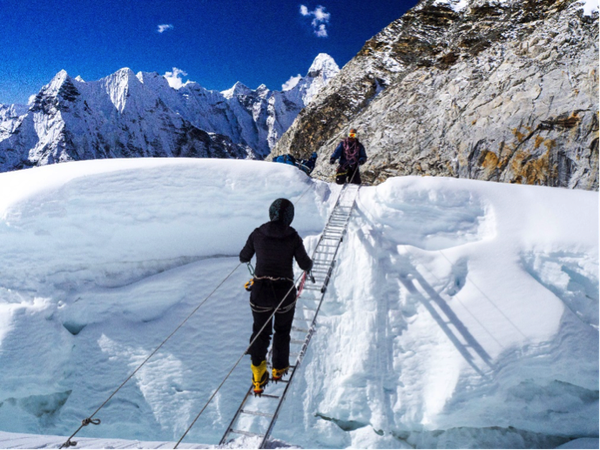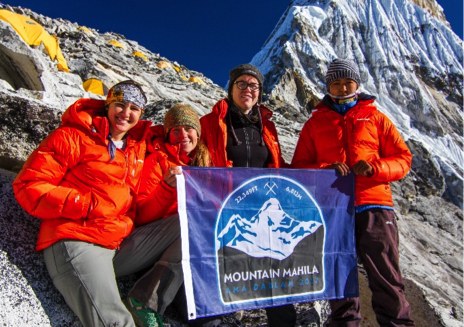
“You have to love the process.”
I repeat these words of climber Ueli Steck in my head over and over as I fight back tears and listen to the thump of helicopter blades getting closer. I have been on this journey for almost four weeks now with the ultimate goal of standing on the summit of Ama Dablam, a 22,349-foot tall peak in the Khumbu region of Nepal. Now I get to watch her spectacular summit and jawdropping ridgelines disappear behind me as I am whisked away to Kathmandu for x-rays and hospital visits.
One year prior, I awoke in a hospital bed, reeling with pain. A rare type of cancer had robbed me of the entire upper lobe of my right lung. I wasn’t sure what my new reality was — if I could ever climb mountains again. Getting up Kite Hill, a mere bump in Seattle’s Gasworks Park, had me out of breath and hunched over. What used to make my heart sing with joy now left me despondent and discouraged. But not for long. I’ve always found a healthy dose of anger will get you back up and running in no time. Attending a mountain film festival a month after surgery did just that. As I watched with my fellow female climbers, I thought to myself, “Where are all the films about women climbers? Why were there no stories of ladies sending rock faces, girls skiing steep powder slopes, or females kicking their crampons into blue water ice?” I know so many fierce, talented, and badass women who inspire me and drive me forwards. Why weren’t films representing them?
Driven by frustration, I conjured a plan to kick my surgery recovery in the butt and in the process make a film for and about women climbers. Considering how many amazing women climbers I know, it wasn’t hard to rally a couple of friends, Tammy and Kim, to join my crazy idea. We wanted to climb something challenging, and Tammy was adamant from the very beginning that Ama Dablam in Nepal was our mountain. She had been on a trip to Nepal previously, hiking next to this iconic peak for weeks. I was scared, it looked frightfully challenging, but we all decided that unless we stepped outside of our comfort zone and tried something we were not sure we could achieve it would not be an adventure.
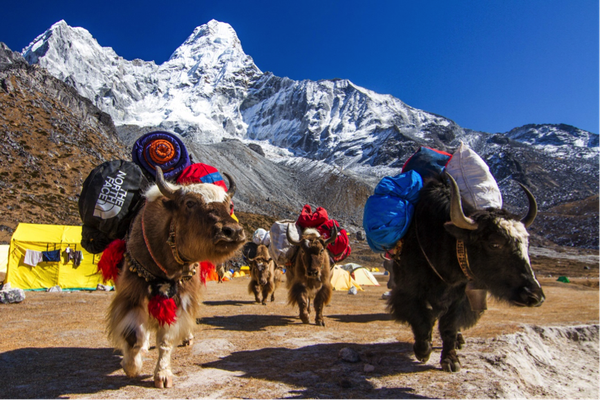
As a group of women setting off to climb in Nepal it seemed only appropriate that our team name should be Mountain Mahila, Mahila being the Nepali word for women. With our summit objective and team named sorted we were all ready to go.
There was, however, one problem: none of us knew anything about film production. We weren’t going to let a minor detail like that stop us. Armed with enthusiasm, we enrolled in a film production course and trolled the internet for any information we could glean. The year that ensued was exciting, heartwrenching, and awe-inspiring. There were ups and downs as I wavered between self-doubt and feeling stronger than ever. We trained hard, and with each climb, I was less out of breath, faster, and almost back to being my pre-surgery self. We filmed, learning how to use the cameras and audio, testing out the weight and awkwardness of the equipment. We failed and tried again, failed again and tried again, and eventually figured the equipment out. As momentum started to build and we began to receive sponsorships and win awards, it suddenly became very real. We were doing this!
It didn’t feel right to climb in Nepal, an economy so reliant on the Sherpa community, without giving something back. We wanted to empower women, not just in our own community, but also in the community where we would be climbing. Sherpas are an ethnic group that lives in many of the mountainous regions of Nepal and are known for their hardiness at high altitude. Sherpas are often used as climbing guides on expeditions in the Himalayas. The word Sherpa has become almost synonymous with anyone that works in the mountaineering industry in Nepal. The climbing scene in Nepal is extremely male-dominated, and while doors are starting to open for women, it is still a long way from gender equality. In fact, when we asked our local agent in Kathmandu if we could have female Sherpas as our guides and porters, we were told they didn’t know of any. It was mindboggling to us that not one female Sherpa could be employed for our expedition.
Traditionally, women in Nepal do not partake in decision making, nor do they have control over family assets, despite commonly being the ones running the tourist teahouses along popular trekking routes. The men are often absent from the family for long periods of time while working as Sherpas or porters for foreign tourists, leaving much of the responsibility of raising families to the women. In recent times, tourism in the region has brought about new economical avenues for the Sherpa communities, and the role of women has shifted. There's been a trend toward Nepali women entering the traditionally male-dominated climbing scene, and in 2016 a local Nepalese woman, thirty-one-year-old Pasang Lhamu Sherpa Akita, was voted Adventurer of the Year for the National Geographic People’s Choice Award. She was recognized for her high altitude climbs and her tireless work in the aftermath of the 2015 earthquake. While new doors are opening for women in Nepal, it is still male dominated, and much work is required before gender equality can be achieved.
As a result, we came up with the idea to sponsor an early career female climbing Sherpa to be a member on our team, hoping that by doing so, she would gain experience and be able to break into the climbing industry.
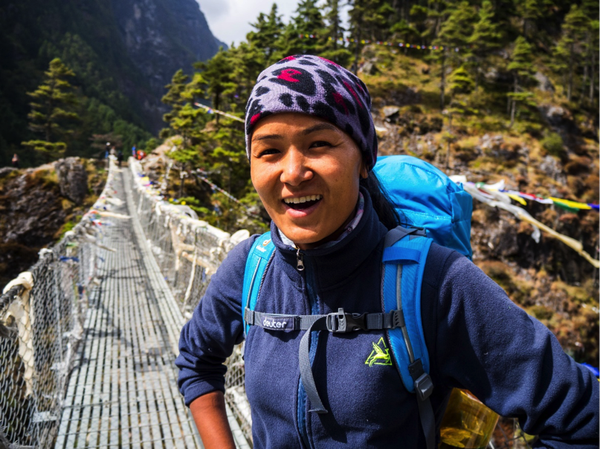 Phurba Sherpa crossing a suspension bridge on the trek between Lukla and Imja Tse base camp. Photo courtesy of Ida Vincent.
Phurba Sherpa crossing a suspension bridge on the trek between Lukla and Imja Tse base camp. Photo courtesy of Ida Vincent.
The following four weeks were spent hiking and climbing alongside one of the most independent, funny, and driven women I’d met. Phurba Sherpa, at 25 years old, completed her basic and intermediate mountaineering courses with the Nepal Mountaineering Association. During her basic mountaineering course she was one of only two women in a group of a hundred students. She dreamt of working as a climbing guide and we were hoping to help make that dream a reality.
Before attempting Ama Dablam, we decided to climb Imja Tse, also known as Island Peak, at 20,305 feet. This would be a great way to acclimatize and warm up for our main objective. We spent eight days hiking from Lukla to Imja Tse base camp, with two of those days being rest days. We quickly learned, however, that “rest days” in Nepal are in fact acclimatization days where you ascend some 3000 feet to a viewpoint, or up a peak. It did not feel much like rest to me. Kim and I had gotten terribly sick, suffering from a bad cold that was making the rounds in all the teahouses. It seemed like every person we met was coughing and sniffling. My body was weakened by a fever, and the mother of all colds had taken ahold of me. Unable to breathe through my nose, I struggled up Chhukung Ri at 18,196 feet the day before we hiked to Imja Tse base camp. Luckily, by the time we reached Imja Tse base camp — a mere 12 hours before we would start our summit push — I finally felt a little better. Kim, on the other hand, was not as lucky. Still suffering badly from her cold, she opted to stay and rest in camp.
I was sad to leave Kim behind as I squirreled out of our shared tent at midnight to eat “breakfast” before our 1am start time. Tammy, Phurba and I lingered, drinking coffee and eating hot porridge, dreading the cold and dark night ahead. At 1:15am, we were ready and left base camp with our Sherpa Nigma. The initial 2,000 feet of gain was straight up, on what was first a trail, then a rock scramble, and finally an exposed rocky ridge traverse to what is known as Crampon Point. I felt slow, still suffering from my cold, and with a new ailment in the form of a tummy bug. Time and time again I had to dash behind a rock, feeling thankful it was still pitch dark outside. At Crampon Point it was time to get into our big mountaineering boots, crampons, and rope up. My feet were frozen, and my fingers turned numb the instant I took my gloves off to attach my crampons. The temperature was lingering around zero degrees Fahrenheit and I was happy to step onto the glacier and keep moving.
Just as the sun started to rise, we got to perhaps the most exciting aspect of the entire climb: a long ladder crossing over a vast crevasse. Four ladders had been strung together and poised over the gaping black hollow below. We took turns cautiously making our way across, focusing on each step until safely reaching the opposite side. Finally, as the sun started to warm our backs, we reached the 328-foot tall headwall, the final crux before the summit. It was near vertical and covered in hard snow and ice. I clipped into the fixed line and started the fight against the altitude. Breathing deeply I labored my way up, kicking my crampons into the ice. Each arduous breath brought us a little closer to the top, and then we were there. We made it!
TAMMY CROSSING THE LADDER ON IMJA TSE WHILE DESCENDING THE MOUNTAIN, AMA DABLAM IN THE BACKGROUND. BY IDA VINCENT.
The views were spectacular, the sun glistened off the snow, and we had made it to the top in 6.5 hours. The summit was tiny, and we struggled to fit our team of four together with a team of two Sherpas who had arrived just ahead of us. Turns out we were the third team to summit that day, and looking down we could see an ant-trail of climbers making their way up behind us. Despite my cold and upset tummy, we made good time. It was an almost surreal feeling standing on top, watching the world spread out below. This was truly the highest I had ever been. It was almost impossible to take it all in. Only after we rappelled down the headwall and were taking our first bit of proper rest in the sunshine did it hit me. The tears started to pour out and later that evening I wrote in my journal, “It is mind-blowing to me that only one year ago, I could barely make it up the stairs. Having to stop to catch my breath, and now only a year later, I summited a 20,305 foot technical peak. I feel proud, lucky, and overwhelmed.”
Exhausted, we continued our trek towards Ama Dablam. After two days, we arrived at Ama Dablam base camp (at 15,000 feet) and got our first real rest day. It was sorely needed. By then I had developed a nasty high-altitude cough, also known as the Khumbu cough. It felt like my lungs were turning inside out each time I coughed. It all seemed a little like type-two fun. When would it start feeling easy and enjoyable? Nonetheless, after a couple days of rest, we slowly started our acclimatization, hiking to Advanced Base Camp (ABC) at 17,000 feet and back down to base camp at 15,000 feet. It felt good to start making headway.
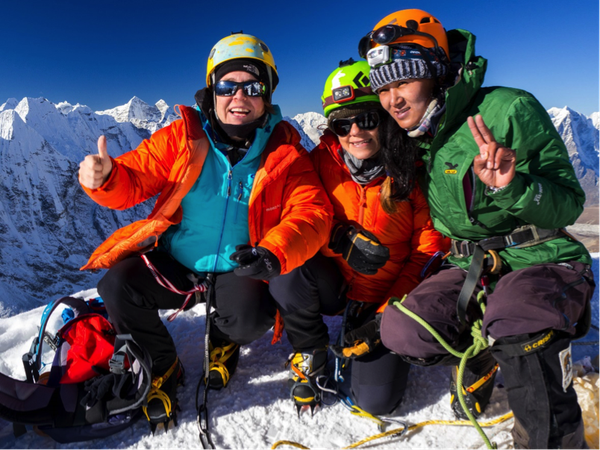 From ABC, the summit seemed closer and more manageable than the pointy pyramid in presented us from base camp. By the time we set off for our second acclimatization venture a couple of days later, my cough was shooting pain through my ribs, and each movement had me yelping with pain. Going uphill was agonizing, the thin air required me to breathe deeply, but each deep breath would send a lightning bolt of pain through my ribs. For me, the entire day was an exercise in pain tolerance. When we eventually arrived at Camp 1, which sits perched on a high ridge (18,370 feet) dropping dramatically off on either side, I had never been so grateful to stop moving. Staying completely still and taking shallow breaths seemed to be the only relief from my pain. I slept fitfully, the pain keeping me awake. When we realized how bad it had gotten, Phurba Sherpa helped arrange a helicopter pick up for me. Then the team hugged me and started up for their summit push. After they left, I stood there alone, trying hard not to feel like a failure as I waited for my helicopter to arrive.
From ABC, the summit seemed closer and more manageable than the pointy pyramid in presented us from base camp. By the time we set off for our second acclimatization venture a couple of days later, my cough was shooting pain through my ribs, and each movement had me yelping with pain. Going uphill was agonizing, the thin air required me to breathe deeply, but each deep breath would send a lightning bolt of pain through my ribs. For me, the entire day was an exercise in pain tolerance. When we eventually arrived at Camp 1, which sits perched on a high ridge (18,370 feet) dropping dramatically off on either side, I had never been so grateful to stop moving. Staying completely still and taking shallow breaths seemed to be the only relief from my pain. I slept fitfully, the pain keeping me awake. When we realized how bad it had gotten, Phurba Sherpa helped arrange a helicopter pick up for me. Then the team hugged me and started up for their summit push. After they left, I stood there alone, trying hard not to feel like a failure as I waited for my helicopter to arrive.
I knew I was leaving the most ambitious project I had ever undertaken behind — not because I choose to, but because I was physically unable to complete what I had set out to do. I had gotten in touch with my surgeon in the US and he advised me to get low and get chest x-rays. Fast.
As soon as the helicopter arrived, tears welled in my eyes and a mixture of disappointment and fear coursed through my veins. In that very moment, it was hard to see the larger picture. I just wanted to stay, climb, be with my team. But I still felt successful, I still loved every single hard, painful, amazing minute of it all. In the end, I had enjoyed the process. Ueli Steck’s words rang true.
“Even if you prepare really really carefully and do all these little small steps, the summit is not guaranteed. So, you really have to love the process. If you look at it that way every expedition is successful.” – the late Ueli Steck, the Swiss Machine.
Epilogue
Once I made it to the hospital in Kathmandu, the doctor’s examination and x-rays confirmed fractured ribs and muscle damage due to a high altitude cough. Who knew that you could fracture your own ribs by coughing? Painful, but thankfully it was nothing that rest and low elevations couldn’t fix. Two days later, on the 17th of November 2017, the rest of team Mountain Mahila stood on the summit of Ama Dablam. As I received the news, sitting in a coffee shop in Kathmandu, I cried with joy, I have never felt such utter happiness for someone else’s success. Me not being there ceased to matter — I was so immensely proud! I still am. I am in awe of these tough, resilient, strong women that I am so very fortunate to also call my friends.
And for Phurba Sherpa, this expedition was particularly successful. She summited both Imja Tse and Ama Dablam, something that will help her immensely in securing work in the climbing industry in Nepal. Our next goal is to have “Mountain Mahila” the film ready by fall 2018.
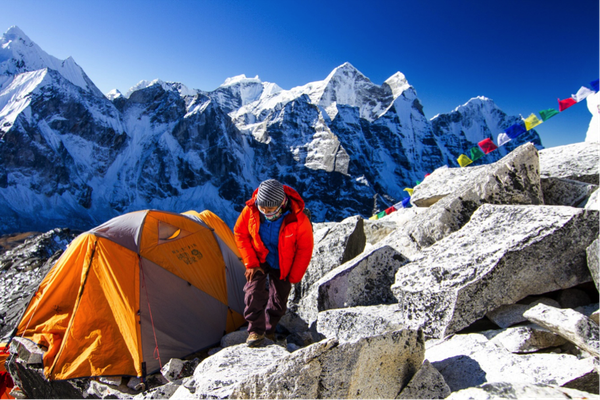
RSVP for the November 15, 2018 showing of their documentary, Mountain Mahila, here.
This article originally appeared in our Summer 2018 issue of Mountaineer Magazine. To view the original article in magazine form and read more stories from our publication, click here.
 Ida Kaller-Vincent
Ida Kaller-Vincent
